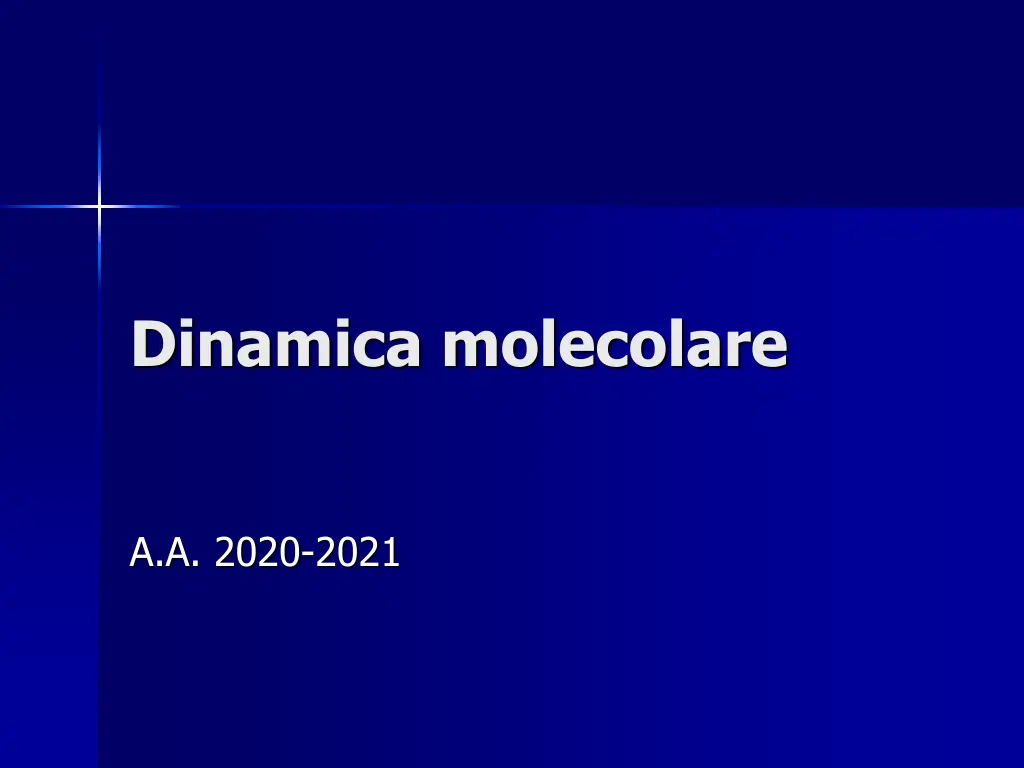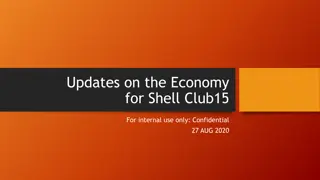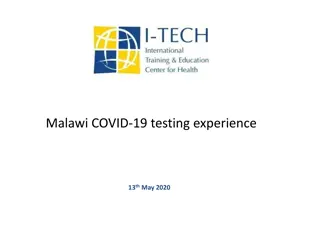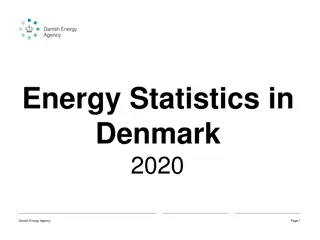
Molecular Dynamics in MD - Fundamentals and Applications
Explore the principles of Molecular Dynamics (MD) from its inception by Alder and Wainwright in the late 1950s to its modern-day applications. Understand the deterministic methodology, the Born-Oppenheimer approximation, energy calculations, and the interplay between potential and kinetic energies in MD simulations.
Download Presentation

Please find below an Image/Link to download the presentation.
The content on the website is provided AS IS for your information and personal use only. It may not be sold, licensed, or shared on other websites without obtaining consent from the author. If you encounter any issues during the download, it is possible that the publisher has removed the file from their server.
You are allowed to download the files provided on this website for personal or commercial use, subject to the condition that they are used lawfully. All files are the property of their respective owners.
The content on the website is provided AS IS for your information and personal use only. It may not be sold, licensed, or shared on other websites without obtaining consent from the author.
E N D
Presentation Transcript
Dinamica molecolare A.A. 2020-2021
Dinamica molecolare (MD) La tecnica MD stata svillupata da Alder e Wainwright tra il 1957 ed il 1959; Le propriet dinamiche di un sistema molecolare sono determinate integrando istante per istante le equazioni di moto di ogni singolo atomo sul quale agisce la forza risultiante dell intero sistema; MD una metodologia totalmente deterministica. ( ) R 2 R R dE d = m 2 d dt Comportamento spazio - temporale del sistema Movimento di atomi in risposta alle forze agenti (variabile tempo)
MD - I punti di partenza 1. Coordinate iniziali e condizioni al contorno. 2. Scelta degli appropriati FF e topologia molecolare. Derivati dalla MM. Velocit iniziali. 3. 4. Numero di passi d integrazione (Np) e altri parametri di simulazione (T , Vol, ttot .).
MD - I punti di partenza l approssimazione di Born-Oppenheimer che permette di riscrivere l equazione di Schr dinger disaccopiando il moto degli elettroni da quello dei nuclei; l Hamiltoniano di una molecola pu esprimere l energia totale solamente come funzione delle coordinate nucleari; Applicando ora l ipotesi semplificativa di validit della MM si pu arrivare a trattare un generico sistema di N molecole come la somma di due contributi, quello potenziale (E) e quello cinetico (K) espressi in funzione delle coordinate R e dei momenti p di ogni atomo n ; Adottando un sistema di riferimento cartesiano le relazioni sono le seguenti: ( ) ( ) p ( ) R = + R p H , K E ( ) ( ) p = R = p 1,...p R 1,...R N N
Energia Potenziale (E) Il termine dell energia potenziale calcolato attraverso l equazione del FF; Conservatit del Campo di Forza FF non dipende dal tempo e dalle velocit Noi possiamo calcolare dell energia potenziale funzioni definite nel FF: = il contributo derivandolo dalle ( ) R F RE i i
Energia Cinetica (K) Il termine cinetico espresso come: 2 p N ( ) = p i K 2m = i 1 i pi il momento dell atomo i ; mi la massa molecolare dell atomo i; indice che tiene conto delle componenti del vettore momento nelle direzioni X, Y e Z degli assi principali.
Molecular Dynamics - MD A system containing N atoms has 6*N values defining the state of the system (3 N coordinates ( R), 3N momenta (p)) impossible to solve analytically the Newton s equation of the motion! need numerical methods
Molecular Dynamics - MD Molecular dynamics alters the intramolecular degrees of freedom in gradual way (step-wise); The steps in molecular dynamics meaningfully represent the changes in atomic position, Ri, over time (i.e. velocity); Newton's equation is used in the molecular dynamics formalism to simulate atomic motion:
Molecular Dynamcis - MD The force on an atom can be calculated from the change in energy between its current position and its position at small distance away; This can be recognized as the derivative of the energy with respect to the change in the atom's position: Knowledge of the atomic forces and masses can then be used to solve for the positions of each atom along a series of extremely small time steps on the order of femtoseconds (fs) = 10^-15 seconds;
Molecular Dynamcis Verlet Algorithm predictor method: the molecular coordinates are assumed based on quantities calculated at the current step or are known from previous steps. the goal is to directly solve the system of second order differential equations given by Newton's law. CONDITIONS: integrate the equation of motion into an infinitesimal time interval such as to consider force as a constant.
Molecular Dynamics Verlet Algorithm coordinates coordinates ) ? ?+ +( (? ?( (? ?) )/ /2 2? ?) ) ? ?2 2 ? ?( (? ?+ + ? ?)= )=? ?( (? ?)+ )+? ?( (? ?) velocities velocities ? ?( (? ?+ + ? ?)= )=? ?( (? ?)+ )+(( ((? ?( (? ?+ + ? ?)+ )+? ?( (? ?) ))/ )/2 2? ?) ) ? ? 1. Given ?(?) and ?(?) at one time point ?, first compute the forces on each atom using the force field. 2. Do an update of the positions ? 3. Do a partial update of the velocity array based on the current forces 4. Compute the new forces ?(?+ ?) using the new positions ?(?+ ?) 5. Finish the update of the velocity array 6. Go back to 1
Molecular Dynamics Verlet Algorithm coordinates coordinates ) ? ?+ +( (? ?( (? ?) )/ /2 2? ?) ) ? ?2 2 ? ?( (? ?+ + ? ?)= )=? ?( (? ?)+ )+? ?( (? ?) velocities velocities ? ?( (? ?+ + ? ?)= )=? ?( (? ?)+ )+(( ((? ?( (? ?+ + ? ?)+ )+? ?( (? ?) ))/ )/2 2? ?) ) ? ? REQUIREMENTS: Verlet algorithm is not a self-starting method!!! Initial coordinates (from experimental techniques or MM) Initial velocities (from Maxwell-Boltzmann distribution) Constant mass (constant number of atom) Constant FF (constant atom types) Time step (dt) must be extremely small 1 fs < dt < 10 fs
Molecular Dynamics d dt It is a step by step resolution : the choice of the t parameter is extremely crucial: determine the success of the algorithm: to limit the calculation time it must be large (less step) but such as to maintain accuracy and conservativeness. it must be physically meaningful. Its order of magnitude generally must be compatible with the physics of the problem : 1 fs < dt < 10 fs.
Molecular Dynamics d dt Time scale Amplitude Description It is a step by step resolution : short femto, pico 10-15- 10-12s 0.001 - 0.1 - bond stretching, angle bending - constraint dihedral motion the choice of the t parameter is extremely crucial: medium pico, nano 10-12- 10-9s 0.1 - 10 - unhindered surface side chain motion - loop motion, collective motion determine the success of the algorithm: to limit the long nano, micro 10-9- 10-6s 1 - 100 - folding in small peptides - helix coil transition calculation time it must be large (less step) but such as very long micro, second 10-6- 10-1s 10 - 100 - protein folding to maintain accuracy and conservativeness. it must be physically meaningful. Its order of magnitude generally must be compatible with the physics of the problem : 1 fs < dt < 10 fs.
MD Units: 1 = 10-10m 1 nm = 10-9m 1 kcal/mol = 4,184 kj/mol 1 fs = 10-15sec 1 ps = 10-12sec 1 ns = 10-9sec 39914 atoms (medium size) 30 atom types 37576 bonds 1 Tesla K20c (2496 cores) 42.27 ns/day 1.76 ns/hour
MD T control Temperature is a quantity that translates the situation at the atomic level through the term kinetic energy into a macroscopic level This relationship depends by the value of the velocity of the atoms (Maxwell-Boltzmann distribution) 2 ?? 2????)1/2? ???? ? ??= ( ??? to initiate MD we need to assign initial velocities! This is done using a random number generator using the constraint of the Maxwell- Boltzmann distribution. the MD simulation involves techniques of evaluation and control of the T that are generally realized using appropriate thermostats.
MD T control The initial assigned velocities are determined in such a way that the Maxwell-Boltzmann distribution is satisfied once the T value has been chosen; During the MD experiment this distribution changes over time as the calculation proceeds; Since this must be constant (in average), the thermostat must be configured as a technique that allows the correct statistical configuration to be generated. thermostat evaluates the difference between set T and calculated T (from the kinetic energy). This difference is re- scaled as a correction factor of the atoms velocities. 1. 2. 3. 4.
MD T control Thermostatic Methods are based on the concept of virtual thermostatic bath Nos -Hoover; Langevin; Andersen; Berendsen The choice of the appropriate thermostat is crucial for MD simulation: to ensure that the average set T of a system be correct No large oscillations during the MD simulation Do not use separate component of your system!!! thermostats for every
MD Periodic Boundary Conditions (PBC) No problems when you simulate isolated molecules (vacuum) A real system might contain about NA= 6 x 1023molecules (1 mol) MD can work only with a small selection Not appropriate to study bulk properties (polymer system, system in solution ) Interactions with the walls Surface interactions Periodic Boundary Conditions: Small box replicated in all directions A particle that leaves the box on one side is replaced by an image particle that enters from the other side There are NO walls and NO surface particles
MD Periodic Boundary Conditions (PBC) Developed by Born and von Karman (1912). The box is multiplied in space, generating a series of cells all equal next to each other whose set forms a real bulk. Actually, a single original cell is simulated (depending on the physical system)
MD - Results MD allow us to determine exactly the temporal space evolution and the properties of a molecular system. RAW data: The integration process leads to obtain a set of values which consists of accelerations of each atom in the analyzed period of time MD trajectory. the N pairs position/momentum of the atoms, which define the mechanical state as a function of time, do not allow any analysis! these information must be connected "characterizing" quantities of the thermodynamic state of the molecular system. positions Ri(t), velocities and with macroscopic
MD - Results To define the thermodynamic state of a molecular system it is necessary to have a series of quantities such as: N = number of atoms; T = temperature P = pressure V = volume ( to density) E = total energy of the system A set of thermodynamic quantities is fixed A template is applied to them (ensemble) Perform the MD simulation Calculate the corresponding energies. 1. 2. 3. 4. 5.
MD Statistical ensembles NVE ensemble (microcanonical ensemble) = It is an isolated system in which the number of particles, velocity and total energy are conserved. NVE corresponds to an adiabatic process in which there is no heat exchange. Unfortunately, NVE does not match the experiments take place. NVT ensemble (canonical ensemble) = constant volume and temperature. In this way the kinetic energy will be constant but the potential energy will vary. the total energy changes. Fundamental in the study of system interactions that requires precise control of T. This is the most physiological approach as this is not an isolated system; to keep the T constant (thermostat). NPT ensemble (isobar ensemble) = constant pressure and temperature. Useful in the equilibration phase in which the other thermodynamic quantities have to converge. conditions at which most heat exchange system
MD Critical Issues The reliability of MD simulation is strictly linked to the accuracy with which the energy equation was developed (extreme importance the choice of the FF MODEL) So, the results of a molecular simulation are determined by the nature of the theoretical model used. the comparison of the results of a simulation with the experimental data is the only unambiguous test for the accuracy of the chosen model! differences between accurate experimental measurements and computational data can be attributed to the failure of the model chosen to represent the molecular system.






















